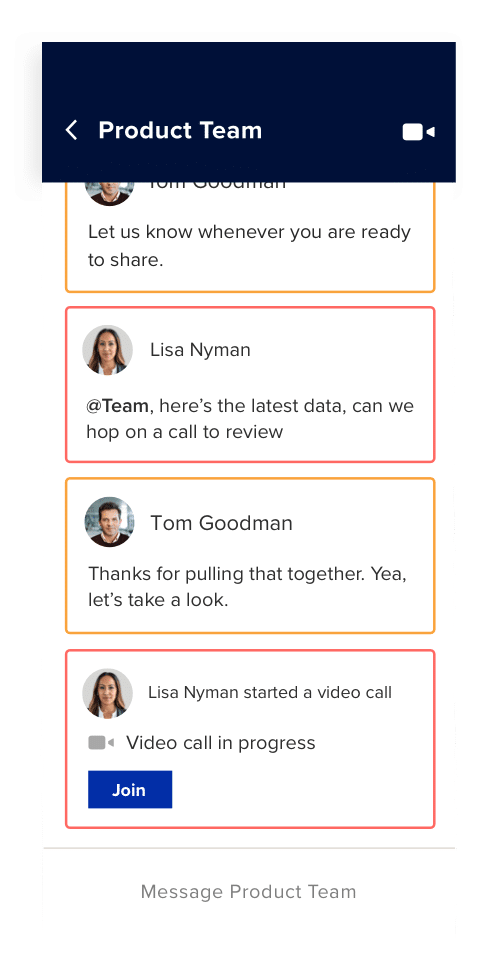Controversial idea of the day: sales meetings should be fun.
They should be the icebreaking highlight on a bad day, and a great morning boost to start off a good one. They should be the training ground where a rep learns and develops and a platform for a sales manager to connect with their employees.
But they’re not.
Instead, most of them feel like a slam of PowerPoint slides, boredom, and stress served fresh on Monday mornings.

From giphy.com
You might have been there.
Because management is hard. Running great meetings is hard.
Many sales managers are great sales reps who got promoted. They’ve got tons of experience and might have closed millions in sales. But they’ve never had experience running sales meetings—and they haven’t been trained to do it either. The new role can feel a bit like being thrown into the deep end without goggles.
If that’s you, don’t worry. We’ve got your goggles.
In this article, we’ll give you:
- The single most important reason to run good sales meetings (actually, there are 30 billion of them)
- Reasons to run weekly and quarterly meetings
- 2 plug-and-play templates for weekly and quarterly meetings
- A 7-step guide to make your next sales meeting a success
- 3 tools you need to run meetings that your sales reps want to attend
- 10 tips to run meetings your reps will look forward to
Start closing more deals. Grab the free outbound sales playbook.
The importance of running a good sales meeting
You need to run a great sales meeting because bad meetings cost money.
In the United States alone, they cost $30 billion, every year.
When European academics Simone Kauffeld and Nale Lehmann-Willenbrock studied 20 organizations from various industries, they found that “dysfunctional meeting behaviors,” such as wandering off-topic, complaining, and criticizing, were associated with things you wouldn’t think had anything to do with meetings at all: lower levels of market share, innovation, and employment stability.
On the flip side, great meetings, while being more productive, leave the staff feeling charged up, connected with their colleagues, valued, and fulfilled.
Should you run weekly or quarterly sales meetings?
Run both. It’s quite important that you maintain a regular cadence of quick and productive meetings to keep your team on the ball. If you can’t afford to run them more than once in two weeks, make sure you’re checking in on your team regularly in another way.
If you can’t run a sales meeting often, use a team messaging app like RingCentral to check in with your team. Create a team chat for weekly check-ins—or even better, message each rep personally.
Make weekly meetings tactical and quarterly meetings strategic. (We’ll show you how to do this in our downloadable templates:
Sales trainer Tom Abbott suggests that sales meetings should be like a habit. Each and every rep should attend, including those on the road or in different time zones—there’s no excuse not to join in and be part of the conversation through a conference call.
If you work with a distributed sales team, make sure you facilitate these regular meetings over video calling. Insist on video because video is a much better vehicle for establishing rapport and creating empathy than either emails or voice calls.
Use RingCentral Video’s HD video meeting features to host bigger sales meetings. You can even use RingCentral Rooms™ if you want to be able to turn any space into a web conferencing destination.
Templates for weekly and quarterly meeting agendas
While you’re busy selling, the last thing you need to be worried about is writing out a new agenda each time. We’ve put together a handy set of templates that you can plug and play—no sales software needed.
How to run a successful sales meeting in 7 steps
1. Circulate the agenda
Using the templates provided (you can modify it to suit your needs), add the key points you want to cover in the “Details” column. Will you go through interesting sales conversation starters or useful sales pitch examples? Circulate the agenda at least 24 hours before the meeting.
During your daily check-ins, ask your reps for input on what they’d like to talk about.
2. Prepare
The second goal of a sales meeting is to cover everything on the agenda. The first? To build a collaborative culture where everyone feels heard. To this end, keep in mind the voices you want to hear from and make a mental note of the people you plan to call on. Who’s done well this week? Who could use a little push?
3. Turn up on time
Be the first to arrive and set up the tech you need to dial in reps who are out of town. Welcome all your sales reps one by one and ask about their day. Check in on them informally before you get down to business.
Learn how to have more productive meetings with the Guide to Better Meetings.
4. Start with a review
Begin the meeting by reflecting on the weekly progress your team has made. Make sure to cheer on the hard workers and applaud top talent.
5. Set aside your slides
In an email or team message, share hefty PowerPoint decks, reports, decisions to be made, and agenda so that everyone can gather their thoughts in advance. This way, discussions remain focused and ramblings are kept to a minimum.
6. Open the floor to questions and sharing
Have your employees open up. Call upon your best-performing reps to share strategies that worked for them that week. Invite everyone to ask questions. If you’re meeting remotely, use screen sharing software to display actual screenshots of their conversation with prospects so everyone can learn from it:

When you ask “Are there any questions?” Pause. Don’t move too quickly on to your next item. Be gentle—people need time to gather their thoughts.
7. End with a bang
Before your sales reps disperse for the day, set a collective goal for the week. If you’ve had the chance to go over a quick technique, ask reps to apply it to their calls and report their experiences the following week.
Tools you need to run a good sales meeting
1. A ritual
A ritual is a great tool for culture-building—no fancy sales apps needed (though those can be useful too). Have fun with it. It could be a group cheer, or if your reps love donuts, it could be your team’s “thing” to have someone bring donuts to every meeting.
For instance, millionaire sales trainer Grant Cardone’s team ends every sales meeting with reading a snippet from his book.
2. A leaderboard
You could have an analog bulletin that’s literally a bulletin board or a whiteboard with a scorecard of the calls made and deals closed.
There are digital dashboards as well—see if your CRM has this feature.
Make sure someone, if not yourself, is keeping tabs on the week’s performance. This is a great way to encourage a bit of healthy competition.
Learn how to create a sales territory plan.
3. RingCentral
A digital communications tool like RingCentral is a great way to keep track of sales teams, even if they’re remote, and get everyone on the same page. Use it to set meetings on the calendar, share the agenda and key team knowledge (like successful client sales meeting agenda examples), and bring your colleagues who are on the road up to speed:
10 tips to run sales meetings your reps will look forward to
Sales teams thrive in a collaborative culture akin to a sports team. Once numbers and targets are out of the way, a sales meeting should morph into a pre-game, morale-boosting huddle just like in sports. A sales leader has to be manager and coach at the same time, bringing out the best in their reps. Here are 10 ways to do that:
1. Start the day strong
Have the meeting in the morning and include a motivating element that keeps everyone’s morale up (more on that later). Don’t hold it in the middle of the day, where it could disrupt your reps’ flow, or at the end, where they may be too tired to concentrate.
2. Measure progress consistently
Track both the weekly effort (calls made, prospecting letters sent out, networking events attended, etc) and the results (deals closed) of your reps to foster accountability.
Working remotely? Create a new team in the RingCentral app and call it “Wins” and allow your reps to announce when they close deals.
3. Mix things up
Have a regular agenda by all means, but keep things fresh and exciting, so there’s something for your reps to look forward to every week. You could do a role-play sales demo one week and a book-reading another.
4. Talk less, listen more
Spend no more than a third of your meeting talking, and spend the rest listening. Have reps share stories about the latest deals they closed. Go over the objections and difficulties they faced, and see what kind of discussions happen when you’re not leading them.
5. Keep the stats to a minimum
Share most of the stats on your communications platform, and spend the scarce face-to-face time connecting with your team.
6. Encourage a bit of competition
While we definitely don’t endorse a toxic work culture, a good sales manager pushes their team to do their best, like a coach on a sports team. A good way to do this is to have a bulletin board that features top performers in full view of the office.
7. Include only those who are relevant to the agenda
If your junior sales reps don’t need to be in on account updates, there’s no need to force them to attend a debrief by your accounting team. Which brings us to our next point:
8. Be a stickler for punctuality
Respect your sales rep’s time. If their salaries are commissions-driven, then time is money and reps will (and rightly) get antsy if your meeting isn’t worth every minute.
9. Don’t micromanage
Micromanaging is firstly, a horrible leadership practice, and secondly, a surefire way to bloat a meeting. Avoid unnecessarily breathing down reps’ necks. “Focus on the why,” says Abbott. “And leave the ‘how’ to them.” Focus on cultivating the right mindset and share tactics, but never force it.
10. Keep the meeting short
Short, regular meetings are like the pulse of your sales team. Infrequent ones are ineffective and overly-long ones, a drag. Focus on quality communication. Have fewer agenda items and spend more time on each item. You can’t cover everything in one meeting (so have regular ones).

Run the sales meetings you wish your boss ran
Finally, the best tip is this. Think back to your own days as an early-career sales rep. What do you wish you got out of your meetings? What did you love about the ones you attended, and what could be better?
Only you as a leader know what your reps need because you’ve been there before. Use the templates, follow the tips, and stay updated with best practices.
And don’t forget to add in the ultimate ingredient in a great sales meeting: a great boss who respects their team’s time!
Originally published Mar 02, 2020, updated Jun 23, 2021






